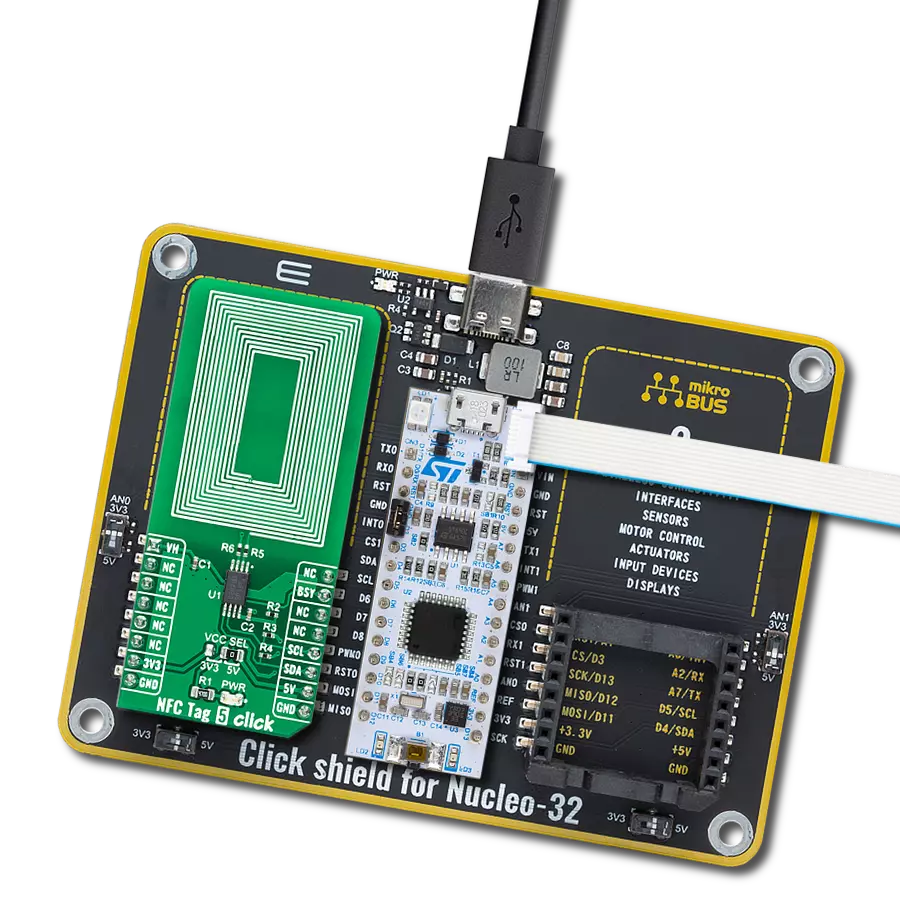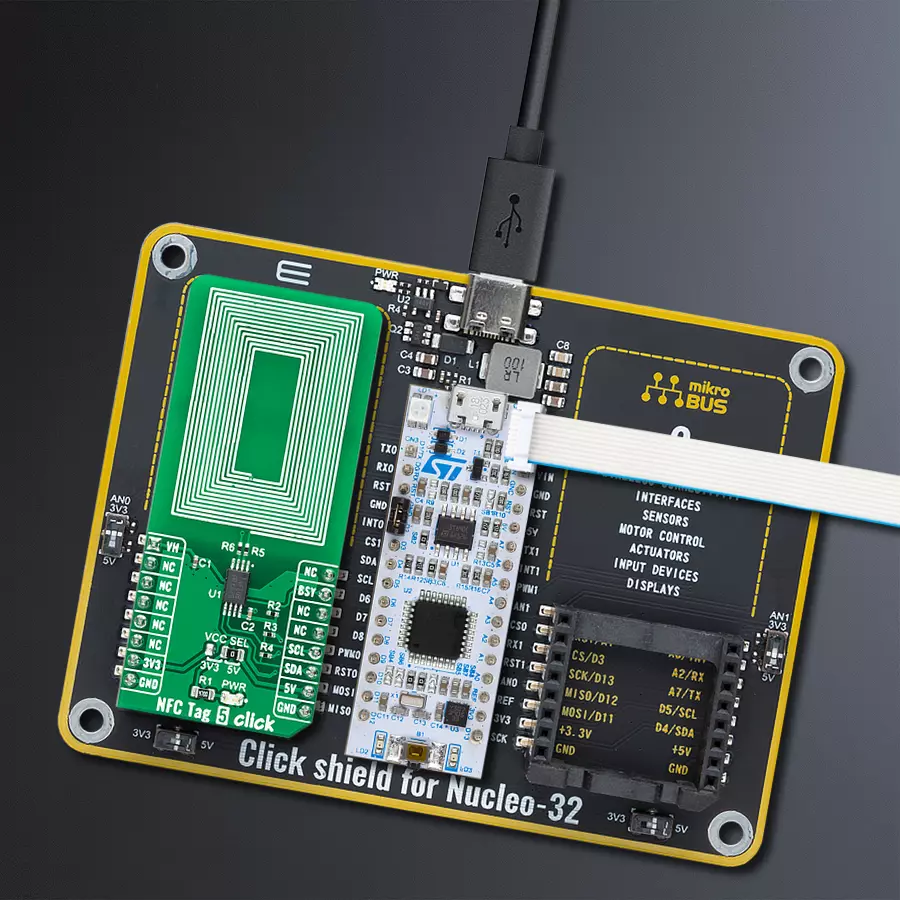Transfer data using short-range RF communication
A
A
Hardware Overview
How does it work?
NFC Tag 5 Click is based on the M24LR64E-R, a 64-Kbit dynamic NFC/RFID tag with password protection, energy harvesting, and RF status functions from STMicroelectronics. This highly integrated Near Field Communication tag module comes with a dual-interface electrically erasable programmable memory (EEPROM), an I2C interface alongside an RF contactless interface operating at 13.56MHz, organized as 8192×8 bits in the I2C mode and 2048×32 bits in the ISO 15693 and ISO 18000-3 mode 1 RF mode. This Click board™ contains the properly tuned integrated trace antenna on the PCB to power and access the device using the ISO/IEC 15693 and ISO 18000-3 mode one protocol. Power is transferred to the M24LR64E-R by radio frequency at 13.56MHz via
coupling antennas. As mentioned, this Click board™ communicates with MCU using the standard I2C 2-Wire interface with a maximum clock frequency of 400kHz, fully adjustable through software registers. It also provides an Energy harvesting mode on the analog pin of the mikroBUS™ socket marked as VH. When the Energy harvesting mode is activated, the M24LR64E-R can output the excess energy from the RF field on the VH pin. If the RF field strength is insufficient or when the Energy harvesting mode is disabled, the VH pin goes into a high-Z state, and the Energy harvesting mode is automatically stopped. Besides, it also features a user-configurable pin marked as BSY, routed to the AN analog pin of the mikroBUS™ socket, used either to indicate that the
M24LR64E-R is executing an internal write cycle from the RF channel or that an RF command is in progress. When configured in the RF write in progress mode, the BSY pin is driven low for the entire RF internal write operation duration. When configured in the RF busy mode, this pin is driven low for the whole period of the RF command progress. This Click board™ can operate with either 3.3V or 5V logic voltage levels selected via the VCC SEL jumper. This way, both 3.3V and 5V capable MCUs can use the communication lines properly. However, the Click board™ comes equipped with a library containing easy-to-use functions and an example code that can be used, as a reference, for further development.



Features overview
Development board
Nucleo 32 with STM32F031K6 MCU board provides an affordable and flexible platform for experimenting with STM32 microcontrollers in 32-pin packages. Featuring Arduino™ Nano connectivity, it allows easy expansion with specialized shields, while being mbed-enabled for seamless integration with online resources. The
board includes an on-board ST-LINK/V2-1 debugger/programmer, supporting USB reenumeration with three interfaces: Virtual Com port, mass storage, and debug port. It offers a flexible power supply through either USB VBUS or an external source. Additionally, it includes three LEDs (LD1 for USB communication, LD2 for power,
and LD3 as a user LED) and a reset push button. The STM32 Nucleo-32 board is supported by various Integrated Development Environments (IDEs) such as IAR™, Keil®, and GCC-based IDEs like AC6 SW4STM32, making it a versatile tool for developers.
Microcontroller Overview
MCU Card / MCU

Architecture
ARM Cortex-M0
MCU Memory (KB)
32
Silicon Vendor
STMicroelectronics
Pin count
32
RAM (Bytes)
4096
You complete me!
Accessories
Click Shield for Nucleo-32 is the perfect way to expand your development board's functionalities with STM32 Nucleo-32 pinout. The Click Shield for Nucleo-32 provides two mikroBUS™ sockets to add any functionality from our ever-growing range of Click boards™. We are fully stocked with everything, from sensors and WiFi transceivers to motor control and audio amplifiers. The Click Shield for Nucleo-32 is compatible with the STM32 Nucleo-32 board, providing an affordable and flexible way for users to try out new ideas and quickly create prototypes with any STM32 microcontrollers, choosing from the various combinations of performance, power consumption, and features. The STM32 Nucleo-32 boards do not require any separate probe as they integrate the ST-LINK/V2-1 debugger/programmer and come with the STM32 comprehensive software HAL library and various packaged software examples. This development platform provides users with an effortless and common way to combine the STM32 Nucleo-32 footprint compatible board with their favorite Click boards™ in their upcoming projects.
Used MCU Pins
mikroBUS™ mapper
Take a closer look
Click board™ Schematic

Step by step
Project assembly
Track your results in real time
Application Output
1. Application Output - In Debug mode, the 'Application Output' window enables real-time data monitoring, offering direct insight into execution results. Ensure proper data display by configuring the environment correctly using the provided tutorial.

2. UART Terminal - Use the UART Terminal to monitor data transmission via a USB to UART converter, allowing direct communication between the Click board™ and your development system. Configure the baud rate and other serial settings according to your project's requirements to ensure proper functionality. For step-by-step setup instructions, refer to the provided tutorial.

3. Plot Output - The Plot feature offers a powerful way to visualize real-time sensor data, enabling trend analysis, debugging, and comparison of multiple data points. To set it up correctly, follow the provided tutorial, which includes a step-by-step example of using the Plot feature to display Click board™ readings. To use the Plot feature in your code, use the function: plot(*insert_graph_name*, variable_name);. This is a general format, and it is up to the user to replace 'insert_graph_name' with the actual graph name and 'variable_name' with the parameter to be displayed.

Software Support
Library Description
This library contains API for NFC Tag 5 Click driver.
Key functions:
nfctag5_write_ndef_uri_recordThis function writes specific NDEF URI record to the memory address specified with NTAG5LINK_NDEF_MESSAGE_START_ADDRESS macro.nfctag5_write_message_to_memoryThis function writes specified number of data bytes to the user memory starting from @b block_addr.nfctag5_read_message_from_memoryThis function reads specified number of data bytes from the user memory starting from @b block_addr.
Open Source
Code example
The complete application code and a ready-to-use project are available through the NECTO Studio Package Manager for direct installation in the NECTO Studio. The application code can also be found on the MIKROE GitHub account.
/*!
* @file main.c
* @brief NFCTag5 Click example
*
* # Description
* This example demonstrates the use of NFC Tag 5 Click board by programming the
* specified NDEF URI record to the memory, and showing the memory read/write feature.
*
* The demo application is composed of two sections :
*
* ## Application Init
* Initializes the driver and logger and performs the Click default configuration which
* formats its user memory. After that it programs the specified NDEF URI record to the memory.
*
* ## Application Task
* Writes a desired number of data bytes to the memory and verifies that it is written
* correctly by reading from the same memory location and displaying the memory content
* on the USB UART approximately every 5 seconds.
*
* @note
* Trying to write/read in RF mode (for example, processing NDEF URI record with a smartphone)
* while writing to memory over I2C is in progress can interrupt and block the I2C communication.
*
* @author Stefan Filipovic
*
*/
#include "board.h"
#include "log.h"
#include "nfctag5.h"
/**
* URL to store to memory as NDEF URI record
*/
#define URI_DATA "www.mikroe.com/nfc-tag-5-click"
/**
* Starting block address to where the text message will be stored
* Must be > ( NFCTAG5_NDEF_MESSAGE_START_ADDRESS + sizeof ( URI_DATA ) / NFCTAG5_MEMORY_BLOCK_SIZE + 3 )
* to avoid overwriting NDEF URI record.
*/
#define TEXT_MESSAGE_ADDRESS 0x0100
/**
* Text message content that will be stored to memory
*/
#define TEXT_MESSAGE "MikroE - NFC Tag 5 Click"
static nfctag5_t nfctag5;
static log_t logger;
void application_init ( void )
{
log_cfg_t log_cfg; /**< Logger config object. */
nfctag5_cfg_t nfctag5_cfg; /**< Click config object. */
/**
* Logger initialization.
* Default baud rate: 115200
* Default log level: LOG_LEVEL_DEBUG
* @note If USB_UART_RX and USB_UART_TX
* are defined as HAL_PIN_NC, you will
* need to define them manually for log to work.
* See @b LOG_MAP_USB_UART macro definition for detailed explanation.
*/
LOG_MAP_USB_UART( log_cfg );
log_init( &logger, &log_cfg );
log_info( &logger, " Application Init " );
// Click initialization.
nfctag5_cfg_setup( &nfctag5_cfg );
NFCTAG5_MAP_MIKROBUS( nfctag5_cfg, MIKROBUS_1 );
if ( I2C_MASTER_ERROR == nfctag5_init( &nfctag5, &nfctag5_cfg ) )
{
log_error( &logger, " Communication init." );
for ( ; ; );
}
if ( NFCTAG5_ERROR == nfctag5_default_cfg ( &nfctag5 ) )
{
log_error( &logger, " Default configuration." );
for ( ; ; );
}
if ( NFCTAG5_OK == nfctag5_write_ndef_uri_record ( &nfctag5, NFCTAG5_URI_PREFIX_4,
URI_DATA, strlen ( URI_DATA ) ) )
{
log_printf( &logger, " NDEF URI record \"https://%s\" has been written\r\n", ( char * ) URI_DATA );
}
log_info( &logger, " Application Task " );
}
void application_task ( void )
{
uint8_t message_buf[ 100 ] = { 0 };
if ( NFCTAG5_OK == nfctag5_write_message_to_memory ( &nfctag5,
TEXT_MESSAGE_ADDRESS,
TEXT_MESSAGE,
strlen ( TEXT_MESSAGE ) ) )
{
log_printf( &logger, " \"%s\" has been written to memory address 0x%.4X \r\n",
( char * ) TEXT_MESSAGE, ( uint16_t ) TEXT_MESSAGE_ADDRESS );
}
if ( NFCTAG5_OK == nfctag5_read_message_from_memory ( &nfctag5,
TEXT_MESSAGE_ADDRESS,
message_buf,
strlen ( TEXT_MESSAGE ) ) )
{
log_printf( &logger, " \"%s\" has been read from memory address 0x%.4X \r\n\n",
message_buf, ( uint16_t ) TEXT_MESSAGE_ADDRESS );
}
Delay_ms ( 1000 );
Delay_ms ( 1000 );
Delay_ms ( 1000 );
Delay_ms ( 1000 );
Delay_ms ( 1000 );
}
int main ( void )
{
/* Do not remove this line or clock might not be set correctly. */
#ifdef PREINIT_SUPPORTED
preinit();
#endif
application_init( );
for ( ; ; )
{
application_task( );
}
return 0;
}
// ------------------------------------------------------------------------ END

































